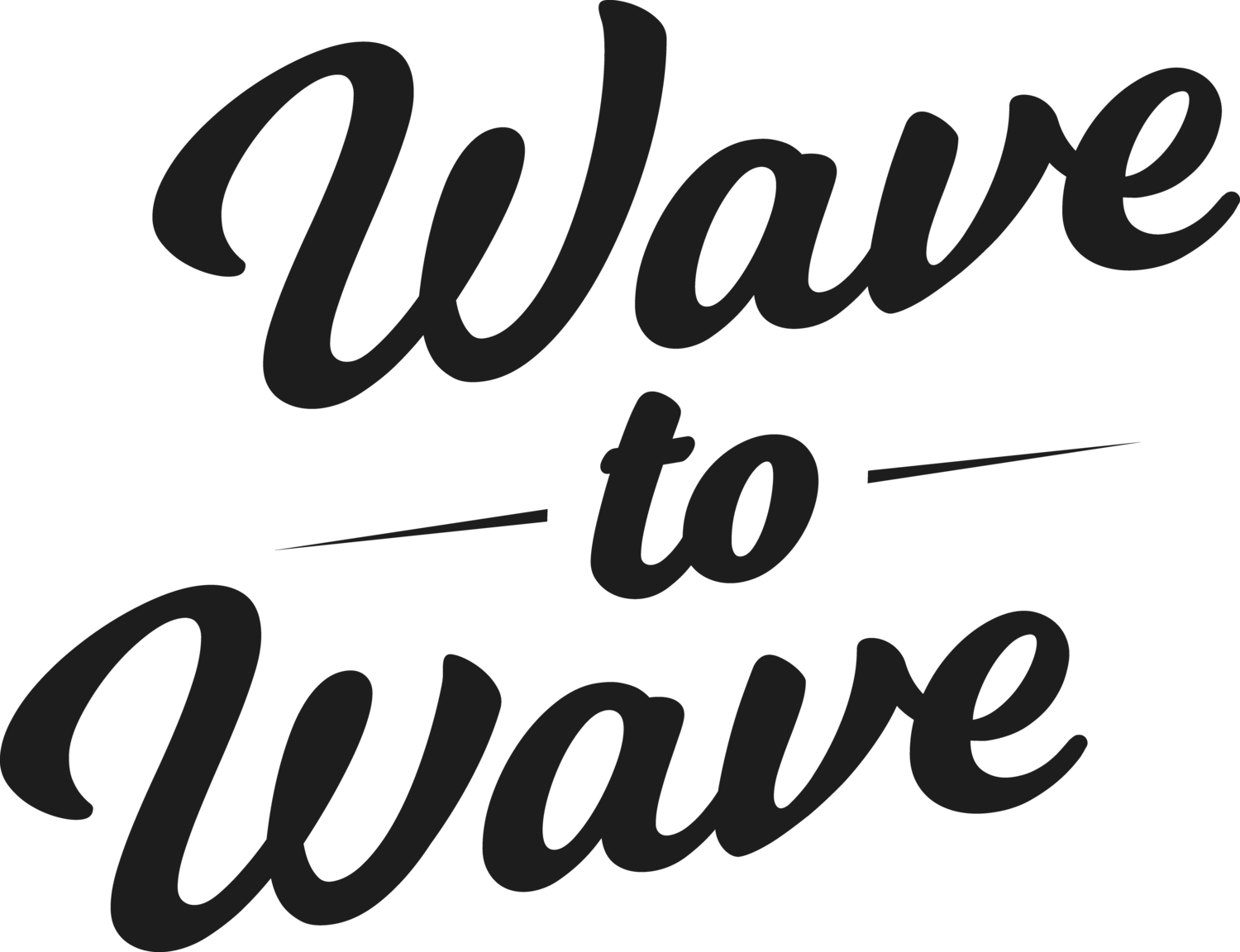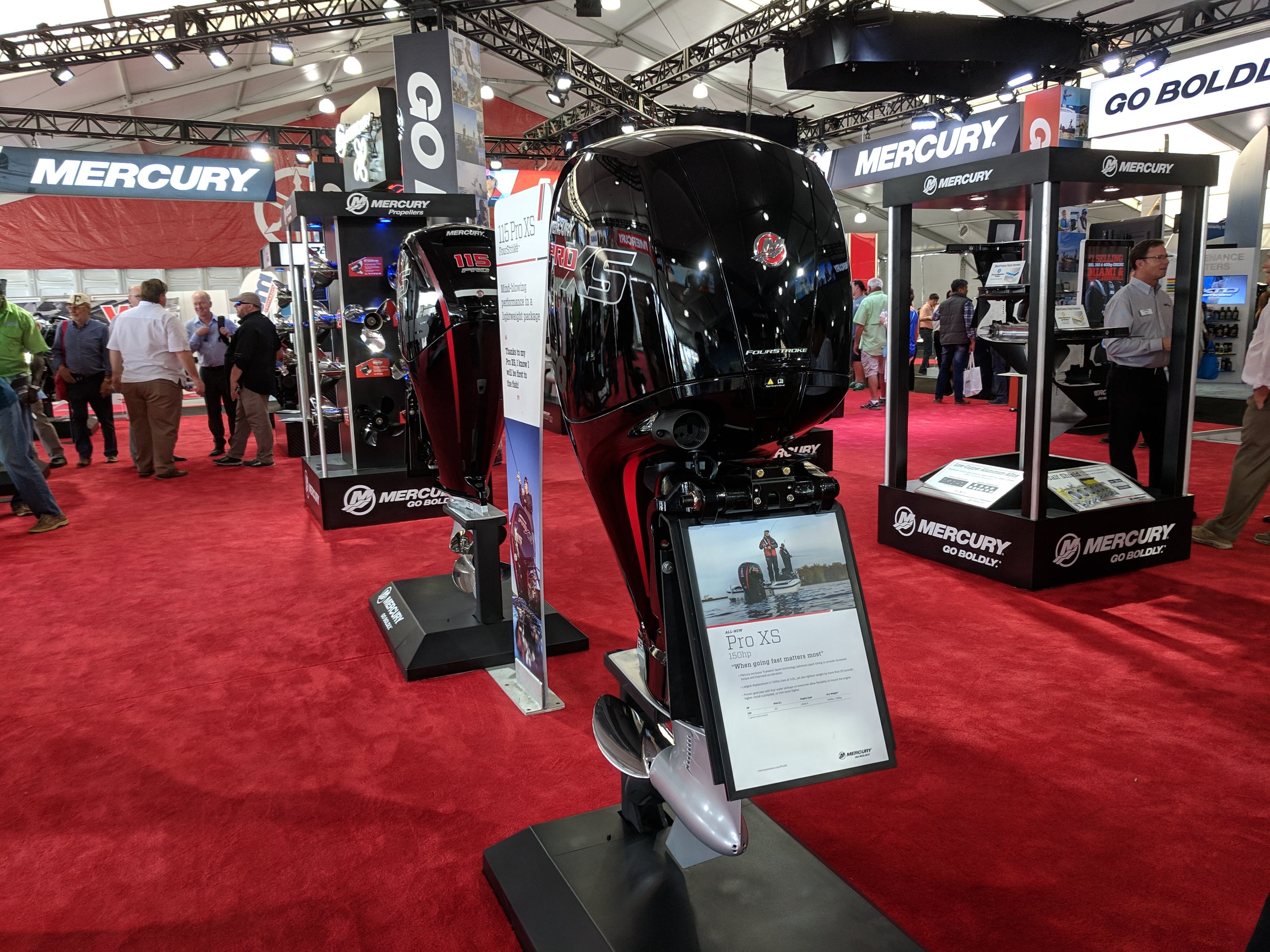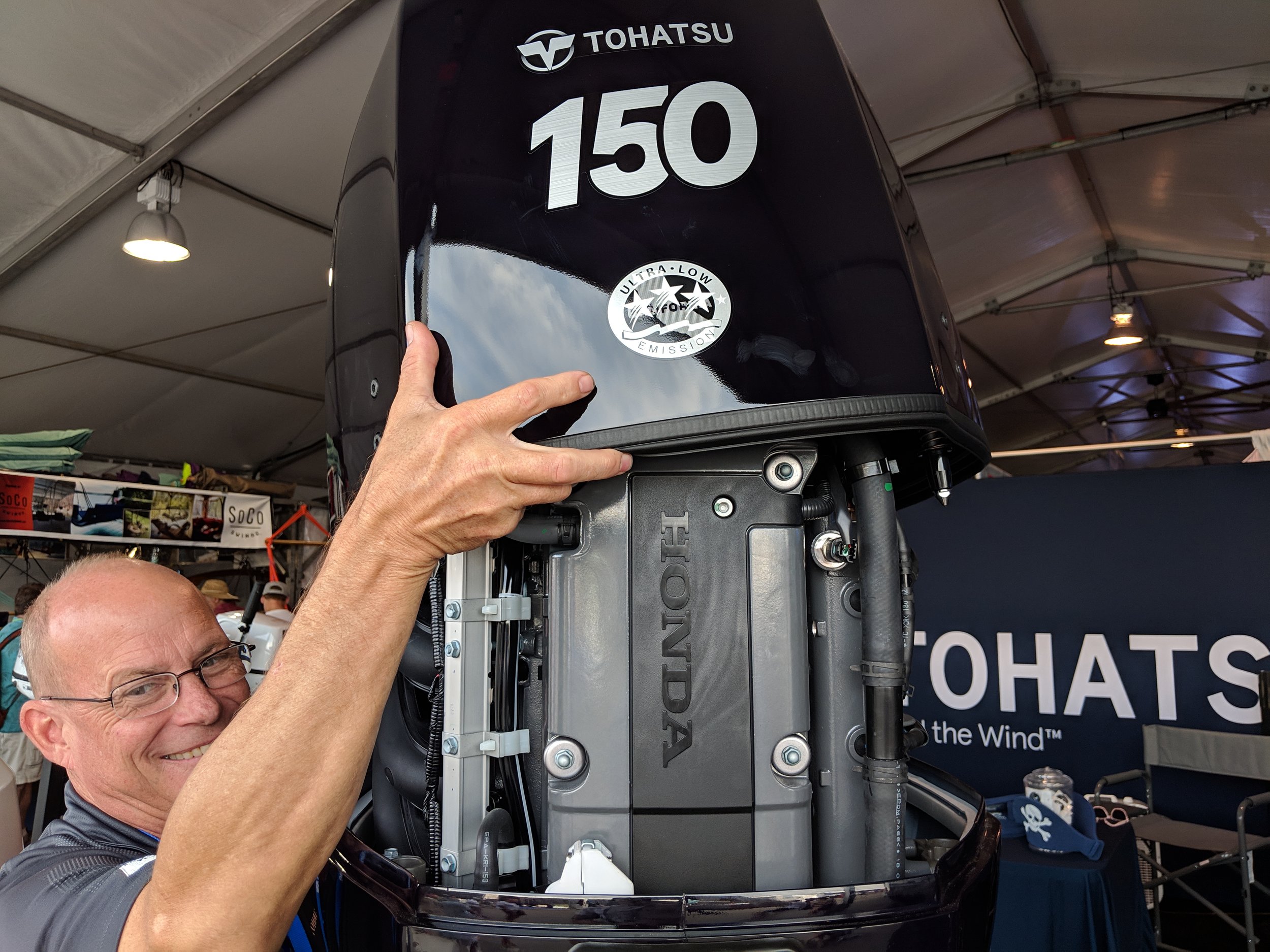The Top Mid Power Outboards of 2019: Lean and Mean
Good things do come in small packages, at least in outboard engines. The mid range horsepower range is an ultra competitive category in the boat world. For high performance, there really isn’t anything out of the box that really is a high performance engine per say, but there are some really good engines, and with minor modifications can be made into economical performers. Many of these outboards are around $12,000 to $15,000 brand new, and the pre-owned market is full of great deals. That’s why I love this category, they are bullet proof engines that can push light boats really well, and are affordable to buy and run. Another reason is most are 4 cylinder four strokes, and they have similar dimensions to the older engines they often replace, whereas four strokes above 200 HP are often the size of a commercial refrigerator.
Because these outboards are primarily built for such a variety of boats, they are missing key performance ingredients. Some have low water pickup, some don’t, and most have gearing for pontoon boats unfortunately. Let’s compare and look at what the best ones are. The criteria is 135 to 200 HP.
At the top of the pack are the 4 cylinder Mercury 150 ProXS and the 4 cylinder Yamaha Vmax SHO 150 and 175 HP. These represent the best of the bunch. Both Mercury and Yamaha dominate most aspects of the outboard game, and it’s easy to see why in this horsepower range, they simply hit most of the marks on weight, gearing, and features.
Yamaha I-4 Vmax SHO 150 - 175
The 4 cylinder Yamahas are interesting engines. With 2.8L of displacement and double overhead cams, the small Yamaha has a sleek design, and is the most powerful 4 cylinder four stroke on the market with their 200 HP offering. But, the Vmax SHO version of the 4 cylinder goes up to 175, and has a few features worth looking at. According to Yamaha’s literature, the 150 and 175 HP SHO weigh slightly less than the F200, at 480 Lbs. A few other potential differences are the intake design, intake camshaft, as well as the ECU tune. The best part is the Yamaha 175 SHO has proper gearing with a 1.86:1 ratio, while the 150 SHO has 2.00:1 gears, which isn’t terrible.
Compact
I love the 2.8L I-4 Vmax SHO. The name could be shorter, and Yamaha could improve their motor mounts on all their engines. If it had better mounts, and low water pickup, this would be a killer 175 outboard.
Surprisingly, the smaller Vmax SHO engines don’t have low water pickup from the factory. If they did, they would be definitively the number one choice. With an aftermarket nosecone kit, and some solid mounts, the compact Yamaha outboard is one of the best choices for a 4 cylinder outboard. Advanced technology, but a proven platform make this a very reliable turnkey performer.
I’d give the 175 HP version of the Yamaha Vmax SHO the edge over the Mercury 150 ProXS based on power and gears. If it was the 150 HP, I’d go with the Mercury. I won’t comment on the ugly colors and graphics the Yamaha SHO engines have. You just have to live with it, or go for a custom paint job.
Mercury 150 ProXS
For overall value, power, and features, the Mercury 150 ProXS is hard to beat. with it’s affordable price, stiffer motor mounts, and low water pickup, you get a pretty good engine right out of the box. It’s biggest downfall is the gearing. The 2.08:1 gears are just a bit low for this HP range. And, the mounts could be stiffer still, it has quite a bit of sloppiness. But, at 163 HP on the dyno, and the ability to rev up to 6,000 RPM, this stout 150 is really nice.
Mercury has pretty much nailed it here, except for the low gear ratio. Everything else it great. And, the size is right for a mid range outboard. Probably the best value in this category.
Although the other engines in this category have double overhead cams, the simple single overhead cam design in the 4 cylinder Merc is fine, it doesn’t hold the engine back, and probably contributes to it being among the lighter engines here. Since the lower unit has low water pickup, this engine is hard to beat stock. Another thing is the engine has a massive 3.0 L displacement, and feels like it has tremendous torque through the RPM range. The Mercury four stroke can cruise all day quietly and efficiently. Based on the long running and proven 3.0L 150 four stroke, this engine is amazing value, and is only about $600 more than the a base 150 Merc. The extra features are worth it. We run a slightly modified Mercury 150 four stroke on our Allison Grand Sport, and it has been great so far.
The gearcase on the 150 ProXS is from the old 4 cyl Verado, a 4.88” with 2.08:1 gears. Not a bad unit, but geared a bit low for anything fast.
Evinrude 150 HO, 200 2.7 Liter
As a fan of competition, I feel this was a missed opportunity for Evinrude. The G2 platform is awesome in so many ways, especially the 3.4 Liter range. But, the smaller 2.7 Liter, 150-200 range is a bit of a letdown. The engines themselves are powerful, and quiet, with super low maintenance, but the letdown is in the details. For one, they are very heavy, weighing 495 Lbs if you opt to not get the built in steering, with the integrated hydraulic steering it balloons to 530 Lbs. The Yamaha four cylinder, is lighter, and it’s considered heavy at 480 Lbs.
The 2.7L G2 is massive, and barely distinguishable from the big 3.4 G2 in size and weight.
From a visual standpoint, you can barely tell the difference from the big block 3.4L Evinrude G2 from the smaller 2.7L version, they are very close in dimensions, it’s massive. This is an advantage the 4 cylinder engines have. Secondly, the Evinrude G2 2.7L has the worst gearing of the bunch at 2.17:1. That is truly gearing for pontoon boats or light duty tug boats. This is the same SLX gearcase found on the 3.4L with 1.86:1 gears, so theoretically you could swap it out, but that would be costly.
By all accounts the 150 HO is a beast of a 150, and the 2.7 goes up to 200 HP. For value, a 150 HO with the standard midsection is a decent deal, but you’d be fighting those gears with a high pitch prop. If you found a used one, and swapped out the gearcase for the 1.86:1 version, you would be doing well. The motor mounts will be soft, but if you addressed that, you would have a solid performer, just a bit heavy. I feel like Evinrude is missing the boat here on all the G2’s, optional gears, and stiffer mounts would make these much improved engines. There is a lot of misinformation about 2 strokes out there, these would be as efficient as the four strokes, and maybe more efficient than the V6 four strokes, especially at higher RPM.
Mercury 3.4 V6 175 ProXS
One reason I didn’t mention this engine earlier is the fact that, like the Evinrude G2, it is just too heavy. Advertised at 470 Lbs, but in the real world, these engines seem to be actually 515 to 520+ Lbs. Heavy cowlings, oil, and some optimistic reporting mean many engines weigh more than advertised. The engine itself is a great design, with a massive 3.4 displacement, nice gearcase with 1.85:1 ratio. Everything checks out, even the price is quite good, but the V6 Mercury takes up a lot of space. Beside other 175 HP engines, it just dwarfs them.
The 175 ProXS is based on the massive 3.4 V6, and will weigh over 500 Lbs at the end of the day, which defeats the purpose of a mid range outboard.
I much prefer the compact design of the 4 cylinder 150 ProXS. If you’re paying the weight and size penalty, get more power than 175 HP. The whole point from a performance perspective in this HP range is to be smaller and lighter. For big heavy boats, these are probably decent.
Considerations
Suzuki has a bunch of 4 cylinder four stokes, and the DF200 is a good engine, but it is extremely heavy at 520 Lbs, and has brutal gearing, 2.50:1. But, the best power to weight option is the DF140, a smaller 4 cylinder that Suzuki has had for a long time, and is a great little engine, that can rev to 6,200 RPM, and weighs in at 394 Lbs. Again, the gearing makes it almost useless on a faster boat, with 2.59:1.
Worth mentioning is the Honda BF 150, which is well documented on Wave to Wave because we worked with 4 Piston Racing on tuning one. Luke and the team at 4 Piston worked their magic. The Honda race engine builders are well known for their work on the Honda K24, which the BF 150 is based on. The block was sleeved with coated Ramey Racing sleeves. Large bore pistons from Wiseco. Saenz Performance connecting rods. ECU by MoTec. And, a custom 4 Piston Racing cylinder head for this application. This was good for about 330 HP at 7,500 RPM. Although it can make the power reliably, it would need some help getting that power to the prop, the stock gears are 2.15:1, and the prop shaft wouldn’t last long being run high for very long. The other four stroke engines here can also be tuned, but don’t have the aftermarket parts like the K24 Honda has, so you would be limited.
Surprise, it’ s a Honda. If you like dark blue, and saving money, this is your engine, the Tohatsu 150.
Ranking the middleweights
1) Yamaha 175 Vmax SHO, 4 cylinder four stroke
2) Mercury 150 ProXS, 4 cylinder four stroke
3) Yamaha 150 Vmax SHO 150, 4 cylinder four stroke
4) Evinrude G2 150 HO - 200HP, 2.7L two stroke.
5) Mercury 175 ProXS, V6 four stroke.
Afterword
In a perfect world, it would be amazing to get the top 5, and run them on the same hull, back to back, and do a full test. The real world is the only way to properly compare.
A nice custom decal treatment on this 150 ProXS on a Carrera fishing boat.













